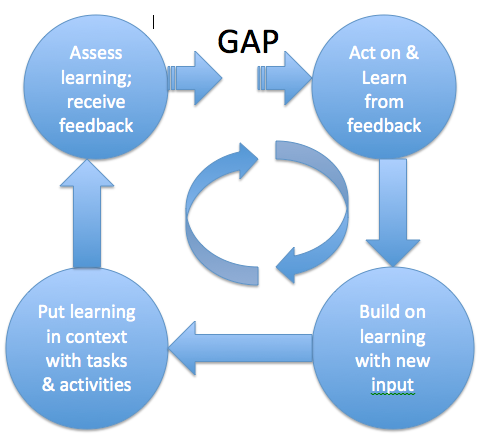What is feedback? Wikipedia indicates that “feedback occurs when outputs of a system are routed back as inputs as part of a chain of cause-and-effect that forms a circuit or loop. The system can then be said to feed back into itself.” This definition may appear at first to apply only to electronic or biological systems (e.g., feedback from a speaker to a microphone or feedback to the pituitary so it can regulate hormone levels). However, it applies equally to education. Have we forgotten that feedback is a cyclical system? Why else would we have called each one of these feedback if they weren’t all the same?
What does this cycle look like? An ideal loop or cycle would be one where the student submits their work, the teacher evaluates this work, the student then reviews the teacher’s comments, and applies them to their next assignment. This kind of conceptualization is best thought of as a positive feedback loop, where the feedback keeps the cycle going. But feedback loops can also be negative, where the feedback stops or ends the cycle. In our case the student who doesn’t use or apply the feedback provided. While it is possible that this is because the student didn’t look at the feedback, it’s equally likely that the feedback itself wasn’t helpful. As Hattie indicates, “students often find teachers’ feedback confusing, non-reasoned, and difficult to understand” (p. 8). This means that students who choose not to look at their feedback may be doing so because their experience has taught them that it is useless.

What is good feedback? Hattie also suggests that “feedback is powerful when it reduces the gap between where the student is and where s/he is meant to be” (p. 2). Therefore, a better way to conceptualize this loop is with a gap such as the example on the right. The only way feedback can close this gap is by providing understandable, actionable things the student can do on their next assignment.
But this is only useful if the student can demonstrate to you that they have applied your feedback. Because of this, it is important to design courses so students have the opportunity to act on your feedback. For example, having two written assignments that only differ in topic, allows students to apply feedback given on their first assignment regarding writing and critical thinking skills, to the second. Without the ability to apply feedback (to you or to their own day-to-day lives), the cycle is likely to end.
Where is my gap in providing feedback? With providing feedback I feel I am heading down the right path. However, as with any journey, there’s always room for improvement. My goal is for feedback to be “user friendly”. By this I mean understandable, actionable, and positive in nature. I strive for feedback that focuses on ways to improve or on alternate ways to think about a topic. For example, instead of saying someone is wrong, which tends to make people defensive, I will ask a question about something they may not have considered – such as “how would x affect this”. These are things I am doing well on so far, but what challenges me the most is how to explain the need for higher level thinking skills in a clear, understandable way.
Leave a Reply